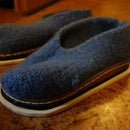Introduction: Rotating Knife Block
Well, there won't be knifes rotating in this instructable, but it will be nice non the less;-)
In this instructable I will show you how I created a rotating knife block with a self built groove ball bearing.
The knife block is round with a diameter of roughly 18cm and a total height of roughly 25cm.
Step 1: Tools and Materials
You will need the following tools:
- A table saw which has a cut depth of at least 6cm (a hand circular saw will most probably not suffice)
- Tensioning belts
- A wood lathe (at least 10cm spindle height)
- belt sander
a rasp (or really hard wood, or really sharp turning gouges;-))
And the following materials:
- Any kind of hardwood beams, at least 8 pieces each 6cmx6cmx20cm (I had 2 Beams of beech, each 1.9m in length)
- board from same kind of hardwood (approx. 20cm x 20cm x 1.9cm)
- Wood glue
- Tape
- approx. 50 steel balls, 1cm in diameter
- spray lacquer
Step 2: Building Concept and the Math!
To build the knife block I decided to cut a groove into the beams and then do two beveled cuts so that 8 pieces, glued together, will form a circle.
The attached scribble shows the profile of beams.
Here you will find a google spreadsheet which helps you with the calculation of the cutting depth:
you just have to provide the groove depth for your knifes (d), the spacing between the beveled cuts (a) and the minimum thickness of your outer shell (t). The formulas will calculate the min beam width and height (h, wmin, wmax) as well as the required cutting depth of your table saw (cdmax, cdmin) (I only had a small one, so I had to go to a friend to cut it), as well as the resulting outer diameter (od).
for the beam width and cutting depth, two values for each are calculated: a full octagon version, and a minimum version (see the pictures for the difference). The full octagon version is easier to glue up because there are common edges on which you can align the pieces, but it requires more wood and deeper cutting depth.
the spacing of the two beveled cuts is very crucial for the resulting diameter of the knife block.
For the bearring two identical V-grooves are cut into a base plate and the block itself with the lathe. Then the steel balls are inserted into the mount between the baseplate and block to act as a bearring. The number of balls needed is approx. ((outerDiameter / 2) - 5mm) * 2 * PI / ballDiameter.
Step 3: Cutting the Wood
First you should bring your beams to the exact same width and height, and plane them to get a good gluing surface.
First cut the Groove for your knives at the desired depth (d) at the exact middle of your beam.
Then turn your beam around and do the beveled cuts at an exact 22,5° bevel. The spacing from the center of the groove cut must be exactly the half of your beveled cut spacing (a).
The beams should be cut to equal length (mine were 22cm)
The base plate is a simple board where you drill a hole in the centre to mount it on your lathe and cut a rough circle (1cm larger than the desired radius of your knife block)
Step 4: Gluing Up the Wood
Add a good amount of glue to all of your beveled cuts and place the pieces on some tape exactly next to each other.
As most beveled cuts are not exactly accurate and only a small deviation from 22,5° will add up quickly you should only glue up the two halfes separately, sand them both plane and then glue them together afterwards. This way you won't have any gluing gaps.
When you are finished adding the glue, take the two halfes, put some sticks between the halves and fasten them together with your fastening belts.
After the glue has dried, sand the two halves plane on your belt sander and glue them together, using the fastening belts again.
Step 5: Turning the Block and Baseplate
Mounting the block in your lathe might be a bit difficult. I used a small piece of wood to put the hole on one side so I could mount it more easily on the spindle.
Now just turn it round using a heavy gouge at the beginning and a spindle gouge at the end.
Also turn the top and bottom plane, so you wil have to do less sanding afterwards.
On one side cut a small V groove (approx. 5mm deep) to hold the steel balls later.
After sanding it up on the lathe, mount the baseplate on your lathe, turn it round and add a groove with the EXACT same radius as on the block (again approx. 5mm deep).
Step 6: Finishing Touches and Further Thoughts
When turning the top of your block plane you will most likely have some rip outs. I used a small rasp to clean those up. After sanding up the top I added a few coats of spray lacquer to the block and the base plate.
Then just put the steel balls in the groove of the baseplate put your block on top, insert knives - et voila: your finished rotating knife block.
Further thoughts.
If I ever build one again, I will try to make a convex shape while turning the block, this way the knifes in the grooves will be visible. I just didn't want to screw up the first version while trying this, as it was a christmas present for a friend.

Participated in the
Protected Contest

Participated in the
Wood Contest

Participated in the
Homemade Gifts Contest













